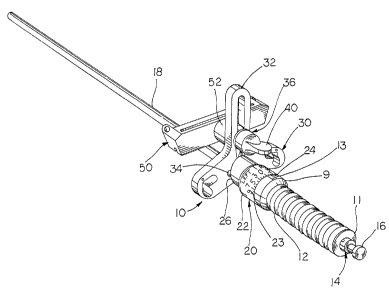Some of the information on this Web page has been provided by external sources. The Government of Canada is not responsible for the accuracy, reliability or currency of the information supplied by external sources. Users wishing to rely upon this information should consult directly with the source of the information. Content provided by external sources is not subject to official languages, privacy and accessibility requirements.
Any discrepancies in the text and image of the Claims and Abstract are due to differing posting times. Text of the Claims and Abstract are posted:
| (12) Patent: | (11) CA 2152768 |
|---|---|
| (54) English Title: | ALIGNMENT GUIDE FOR USE IN ORTHOPAEDIC SURGERY |
| (54) French Title: | GUIDE D'ALIGNEMENT POUR CHIRURGIE ORTHOPEDIQUE |
| Status: | Deemed expired |
| (51) International Patent Classification (IPC): |
|
|---|---|
| (72) Inventors : |
|
| (73) Owners : |
|
| (71) Applicants : |
|
| (74) Agent: | GOWLING WLG (CANADA) LLP |
| (74) Associate agent: | |
| (45) Issued: | 2005-08-30 |
| (22) Filed Date: | 1995-06-27 |
| (41) Open to Public Inspection: | 1995-12-28 |
| Examination requested: | 2002-06-13 |
| Availability of licence: | N/A |
| (25) Language of filing: | English |
| Patent Cooperation Treaty (PCT): | No |
|---|
| (30) Application Priority Data: | ||||||
|---|---|---|---|---|---|---|
|
The alignment guide of this invention includes a cam rotatable about the longitudinal axis of the alignment guide as defined by an intramedullary rod. A base plate is pivotally connected to the intramedullary rod and includes a pair of cam followers positioned on opposite sides of the intramedullary rod. In use, as the cam is rotated relative to the rod, the cam followers ride against the cam causing the plate to pivot or angulate relative to the rod. A plurality of indicia are formed on the cam to indicate to the surgeon the relative angle between the plate and the rod. The base plate includes a quick connect mechanism to permit the surgeon to quickly attach a device such as a cutting guide or pinning guide to the base plate. The cutting guide is fixed relative to the base plate such that the cutting guide will be at the same angular orientation as the plate relative to the intramedullary rod.
Le guide d'alignement de cette invention comprend une came rotative autour de l'axe longitudinal du guide d'alignement tel que défini par une tige intramédullaire. Une plaque de base est raccordée en pivot à la tige intramédullaire et comprend deux galets sur les côtés opposés de la tige intramédullaire. En utilisation, comme la came pivote autour de la tige, les galets se déplacent contre la came et font ainsi pivoter ou former un angle par rapport à la plaque par rapport à la tige. Une pluralité d'indices est formée sur la came pour indiquer au chirurgien l'angle relatif entre la plaque et la tige. La plaque de base comprend un mécanisme de fixation rapide permettant au chirurgien de fixer rapidement un périphérique tel qu'un guide de coupe ou un guide de tige à la plaque de base. Le guide de coupe est fixe par rapport à la plaque de base de manière à ce que le guide de coupe soit orienté en angle de la même manière que la plaque par rapport à la tige intramédullaire.
Note: Claims are shown in the official language in which they were submitted.
Note: Descriptions are shown in the official language in which they were submitted.

For a clearer understanding of the status of the application/patent presented on this page, the site Disclaimer , as well as the definitions for Patent , Administrative Status , Maintenance Fee and Payment History should be consulted.
| Title | Date |
|---|---|
| Forecasted Issue Date | 2005-08-30 |
| (22) Filed | 1995-06-27 |
| (41) Open to Public Inspection | 1995-12-28 |
| Examination Requested | 2002-06-13 |
| (45) Issued | 2005-08-30 |
| Deemed Expired | 2015-06-29 |
There is no abandonment history.
Note: Records showing the ownership history in alphabetical order.
| Current Owners on Record |
|---|
| BURKE, DENNIS W. |
| PETERSEN, THOMAS |
| BRISTOL-MYERS SQUIBB COMPANY |
| Past Owners on Record |
|---|
| BAYS, RODNEY L. |
| KRUEGER, DAVID |